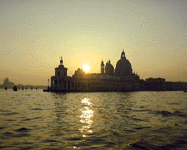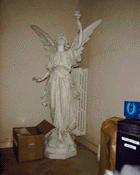 Rahul Gupta
Rahul Gupta
The cs99d final projects took many forms, including papers, drawings, computer models, and computer programs. This page includes some of the online content of the computer-oriented projects. Click on a picture to see the corresponding project. There were many other fascinating projects; this is just a sampling of those projects suited to the web.
In this beautifully designed and playfully animated PowerPoint slide show, Jennifer Zwarich surveys, then analyzes the gelato shops of Florence. This is a must-see. Warning: it is 10MB.

In this project, Rahul Gupta, Daniel Perkel, Semira Rahemtulla, and Alex Roetter experiment with the idea of using a system of projectors to illuminate the surface of a free-standing statue with an aligned computer-generated image of the same statue. Why would you want to do this? Click to find out.
Using the streets, buildings, and waterways of Italy as source material, several students shot and assembled photographic demonstrations of some of the optical effects described in M.G.J. Minnaert's classic book, Light and Color in the Outdoors.
|
|
|
|
| 1 | 2 | 3 |
In this brave project, Maisie Tsui and Alana Chan reconstructed one of the famous panels with which Filippo Brunelleschi demonstrated in 1413 to his amazed colleagues that he had developed a method for making correct perspective drawings.
Referring to figure 1, Maisie and Alana first made a perspective drawing (A) of the Baptistry of Florence as seen from a station point near the central door of the cathedral. Next, they mounted their drawing flat on a mirror (B) and drilled a peephole (C) in the mirror. Finally, they positioned the mirror such that the peephole coincided with their station point; you can see the cathedral door in the background. An observer (D) stands behind the mirror and looks through the peephole. The observer's lines of sight go through the peephole, bounce off a second mirror (E), spread out to encompass the drawing. What they see is a drawing of the bapistry and, if the construction is correct and the mirrors are properly placed, the real sky beyond the bapistry, as reflected in the mirror on which the drawing is mounted. If the construction is incorrect, they would instead see parts of the bapistry or they would miss parts of the sky. Unfortunately, Brunelleschi's panel is now lost, and the sizes and placements of the drawing and mirrors are not known for certain. As a guide, Maisie and Alana used the parameters suggested by Martin Kemp in his monograph, The Science of Art.
After several false starts (and broken mirrors), which Maisie and Alana document in a paper describing their project, they got the illusion to work (figure 2). This fact was carefully verified by each of their classmates on this fine sunny day (figure 3), as well as by a stream of tourists who also wanted to look through the peephole. The biggest problem with their reconstruction was the scotch tape brackets, which were insufficiently rigid to hold the illusion in place for long. Given the complicated optical path, a more rigid mounting system is needed.